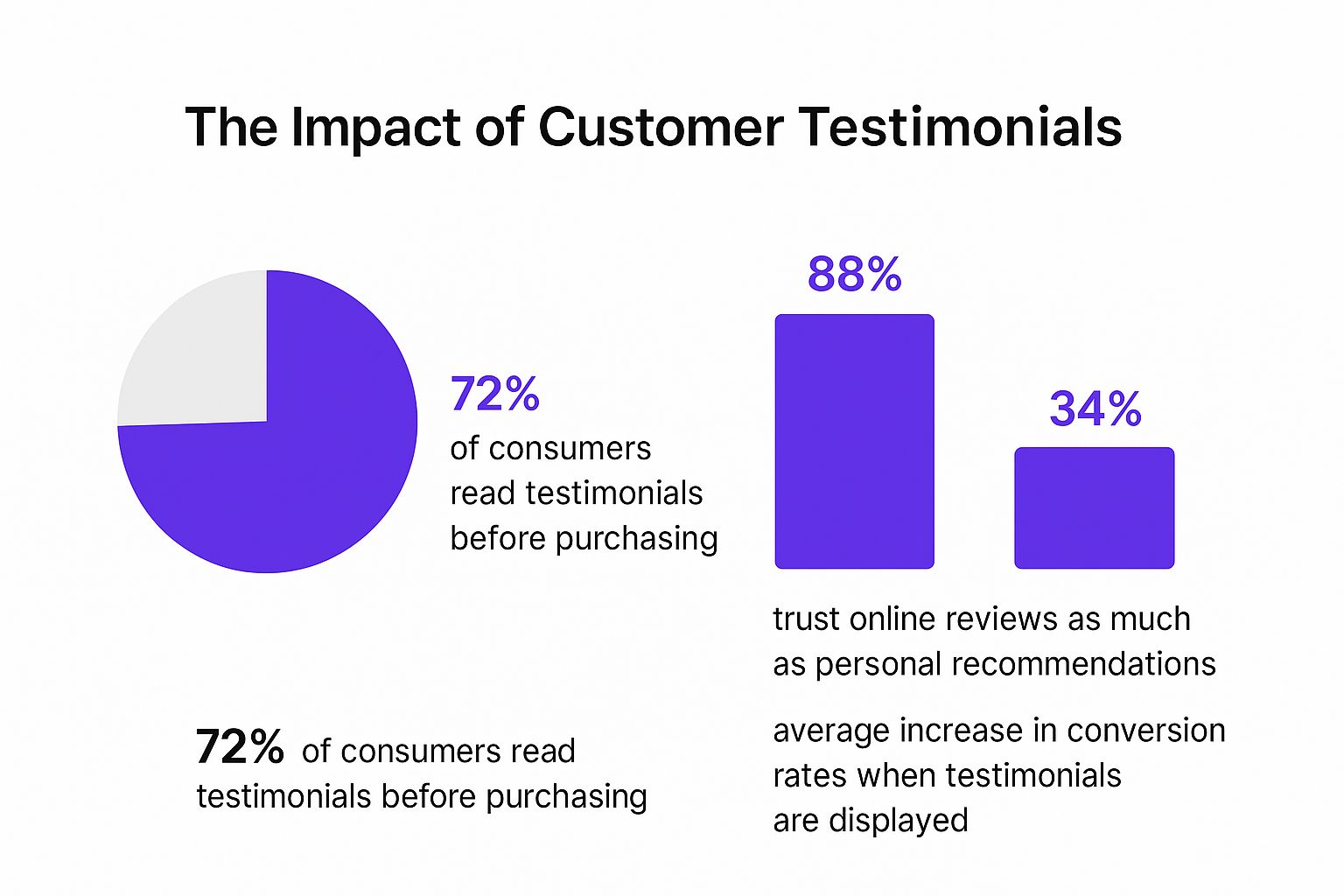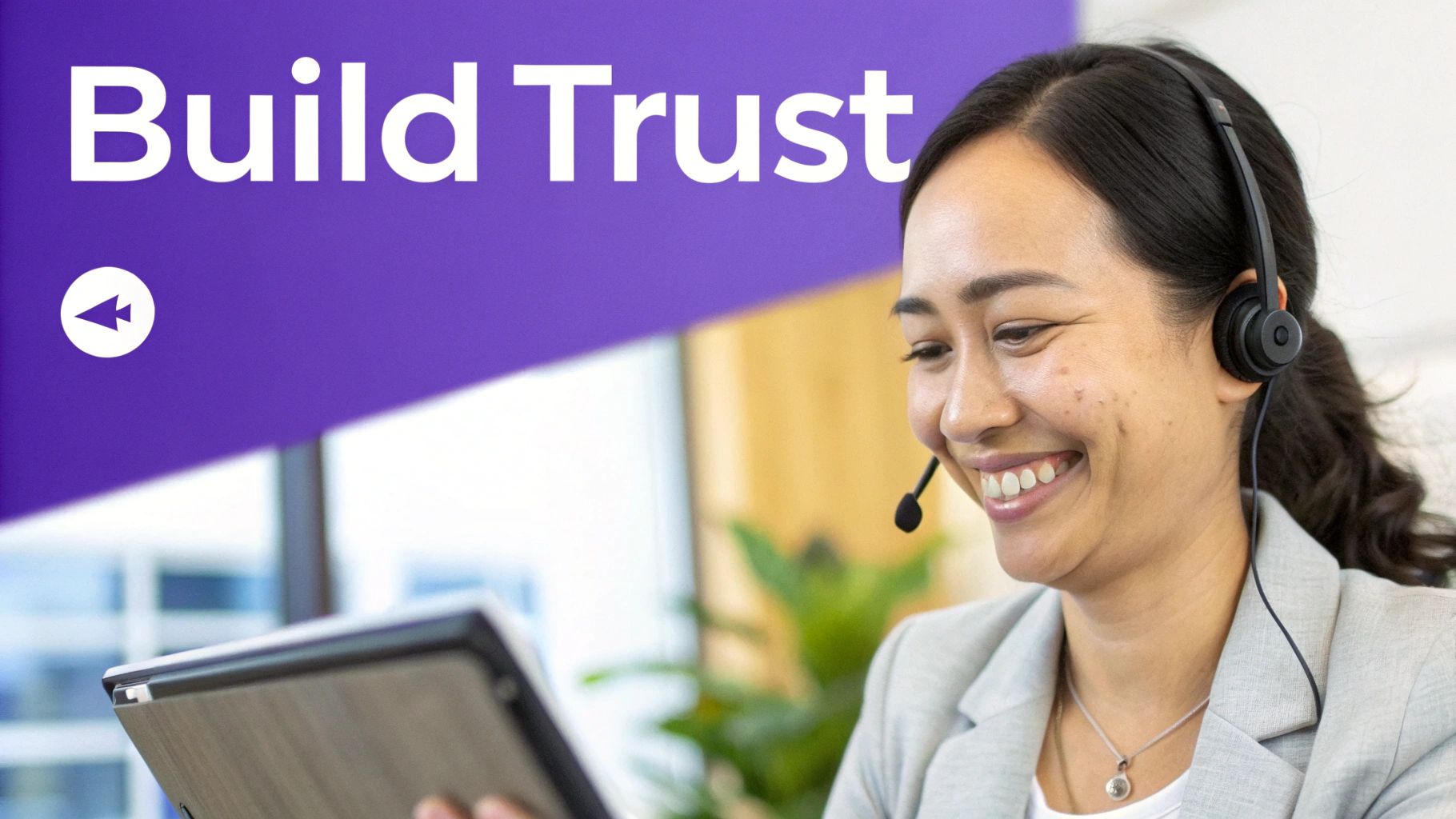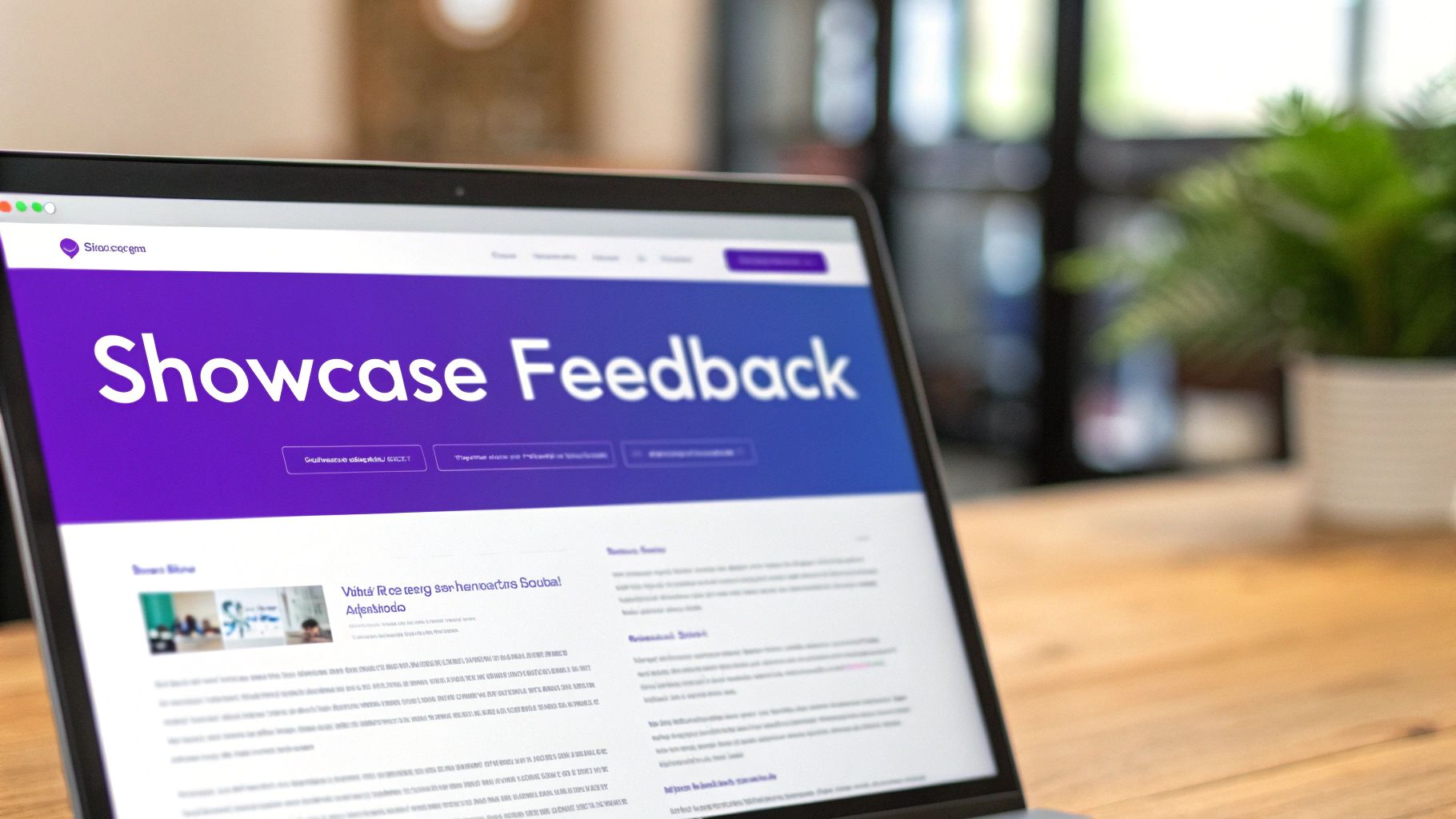How to Ask for Testimonials: Proven Strategies to Get Results
Learn how to ask for testimonials effectively. Discover timing, templates, and tips to gather authentic social proof and boost your business.
Posted by
Why Testimonials Transform Your Business Results
Testimonials are more than just kind words; they're a vital part of a successful marketing strategy. They offer social proof, showing potential customers the real benefits of your product or service. This builds trust, especially when it's hard to stand out from the crowd. Think about your own online shopping habits. Do you check reviews before buying? Most people do.
The Power of Peer Influence
Testimonials are effective because they use the power of peer influence. We trust recommendations from people like us, even strangers. This is even more true now, with so many marketing messages online. Testimonials feel authentic and genuine, unlike traditional ads. They can also address specific customer concerns, making people feel more comfortable buying.
Quantifiable Impact on Business Growth
This trust leads to higher sales. Businesses that actively seek testimonials see significant growth. Studies reveal that 72% of customers trust a business more after reading positive reviews. Displaying testimonials can increase sales by up to 270%. Testimonials are especially important for B2B sales. 92.4% of B2B buyers use reviews to make decisions. Companies featuring testimonials see up to 62% higher annual revenue. More statistics can be found here: https://wisernotify.com/blog/testimonial-stats/. Need help getting started? This guide offers helpful advice on how to ask for testimonials. These numbers show how important testimonials are for any marketing plan.
To help illustrate the benefits of using testimonials, let's look at the following data chart which compares businesses that actively use testimonials with those that don't across various metrics.

The data chart clearly shows the positive impact of testimonials. Businesses using testimonials saw improved results across all metrics. This emphasizes the value of testimonials for business growth.
To further break down the impact of testimonials across different business types, let's look at the following comparison table:
The table below, "Impact of Testimonials Across Business Types," compares how testimonials affect different business models and industries.
| Business Type | Trust Impact | Sales Impact | Customer Acquisition Cost Impact |
|---|---|---|---|
| E-commerce | High | High | Moderate |
| SaaS | High | Moderate | High |
| Local Services | Moderate | High | Low |
| B2B | High | High | Moderate |
This table highlights the impact of testimonials across various business types, showcasing how they can improve trust, boost sales, and reduce customer acquisition costs. While the degree of impact may vary, the overall trend demonstrates the value of testimonials for businesses across various sectors.
Visualizing the Impact
This section further illustrates the data with specific examples.
- Conversion Rates: Businesses using testimonials have 20% higher conversion rates.
- Sales Revenue: Companies with testimonials see a 30% increase in sales revenue.
- Customer Acquisition Cost: Testimonials can lower customer acquisition cost by 15%.
Actively using and displaying testimonials isn't just a smart move; it's a crucial part of a successful marketing strategy.
The Perfect Moment: When to Ask for Testimonials
Timing is everything when it comes to requesting testimonials. Asking for feedback at the right moment can significantly improve your chances of receiving a positive and thorough response. This means understanding the customer journey and pinpointing those emotional high points where customers are most likely to share their positive experiences. Think about a customer who just successfully launched their website using your platform – that's the perfect time to ask!
Identifying Key Moments in the Customer Journey
Successful businesses strategically identify these key moments. For example, right after a customer achieves a major milestone using your product or service is an ideal time. Also, consider reaching out after a positive interaction with your customer support team. This highlights the value you provide and often creates a natural opportunity to request a testimonial.
Automating Requests While Maintaining a Personal Touch
Many businesses use automation to trigger testimonial requests after specific events, such as a completed purchase or project. However, keeping a personal touch is still crucial. Personalized emails that reference the customer's specific experience, or a quick follow-up message thanking them for their business, can make all the difference. This combination of automation and personalization streamlines the process while preserving genuine connection. To capture the best feedback, businesses often ask for testimonials immediately after a positive interaction, such as after a purchase or resolving an issue, ensuring the feedback is fresh and detailed. Find more detailed statistics here.
Timing Strategies Across Different Industries
Different industries benefit from unique timing strategies. E-commerce businesses frequently request testimonials immediately after a purchase, while SaaS companies might find it more effective to ask after a customer successfully integrates their software.
- E-commerce: Post-purchase follow-up emails.
- SaaS: After successful onboarding or achieving key milestones.
- Service-Based Businesses: Upon completion of a project or service.

By understanding your industry's specific characteristics and identifying the emotional highs within your customer journey, you can greatly improve your chances of gathering powerful and persuasive testimonials. This careful attention to timing will ultimately result in more effective social proof and higher conversion rates.
Crafting Requests That People Actually Answer
Timing is everything when asking for testimonials, but how you phrase your request is just as critical. A poorly written request can be a turn-off, while a well-crafted one can significantly improve your response rate. This section explores the psychology behind effective requests and how to encourage customers to share their experiences without feeling pressured.
Understanding the Psychology of Persuasion
Effective testimonial requests leverage key psychological principles. Reciprocity is a powerful motivator; when you've provided value to a customer, they're often happy to return the favor. Social proof also plays a role; showcasing how others have benefited from sharing their experiences can encourage participation. Finally, personalization is crucial. Generic requests tend to be ignored, while tailored messages show you value the individual's unique experience.
Key Elements of a Compelling Request
Every request should include a few essential elements. Clearly explain why you're asking for the testimonial and how it will be used. Outline the benefits to the customer, such as highlighting their success or helping others make informed decisions. Provide clear instructions on how to submit the testimonial, simplifying the process as much as possible. Lastly, always express your gratitude for their time and feedback.
Crafting Requests for Different Channels
Your approach should adapt to the communication channel. For email outreach, a personalized message referencing a specific interaction or achievement is effective. For in-person conversations, a direct and enthusiastic request, followed by a written reminder, can work well. On social media platforms, engaging with positive comments and requesting permission to repurpose them as testimonials is a smart strategy. Learn more in our article about How to master testimonial requests.
To help you craft effective requests, we've compiled a table of ready-to-use templates:
The following table provides templates for requesting testimonials across various communication channels. It highlights key elements and provides estimated response rates to help you choose the best approach for your needs.
| Channel | Template | Key Elements | Response Rate |
|---|---|---|---|
| "Hi [Customer Name], I'm reaching out because I was so impressed with your recent success using [Product/Service]. Would you be willing to share your experience in a short testimonial? It would be incredibly helpful for other businesses considering [Product/Service]. Simply reply to this email with a few sentences, and let me know if you have any questions. Thank you!" | Personalized greeting, specific achievement reference, clear instructions, expression of gratitude | 10-15% | |
| In-Person | "Hi [Customer Name], I was wondering if you'd be open to sharing your positive experience with [Product/Service] in a testimonial. It would be a huge help to us. I can follow up with an email containing all the details." | Direct and enthusiastic ask, offer of follow-up | 20-30% |
| Social Media | "Hi [Customer Name], We loved your recent comment about [Product/Service]! Would you mind if we used it as a testimonial on our website and social media channels? Please let us know!" | Reference to specific comment, request for permission | 30-40% |
This table offers a starting point for crafting compelling requests. Remember to adjust the templates to fit your specific brand and audience.
Templates and Language Patterns That Work
Here are some examples of effective language patterns to incorporate:
- Focus on the "why": "Your feedback is invaluable as we continually improve our services."
- Highlight the benefits: "Sharing your story can help others find the right solution."
- Make it easy: "Simply reply to this email with a few sentences about your experience."
- Express gratitude: "Thank you for sharing your valuable insights."
Personalizing Requests at Scale
Personalization is vital, but can be challenging to maintain at scale. Successful businesses use tools and techniques to automate this process. Email marketing platforms allow you to insert custom fields based on customer data. You can also segment your audience based on their interactions with your product or service, enabling more targeted messaging. This ensures each customer receives a request that feels personal and relevant. You might also be interested in: How to master testimonials further and craft even more compelling requests.
This careful blend of personalization, clear communication, and an understanding of psychological principles can drastically improve your testimonial response rates, providing valuable social proof for your business.
Getting Specific Results That Actually Convert
Generic testimonials like "This product is great!" rarely make an impact. What truly resonates with potential customers are specific, results-driven testimonials. This section explores how to guide your customers toward providing detailed feedback that showcases the real impact of your product or service. Think of it like this: a restaurant review that simply states "The food was good" is far less convincing than a detailed description of a delicious pasta dish and its unique flavors.
Asking the Right Questions
The key to compelling testimonials lies in asking the right questions. Instead of requesting general feedback, structure your questions to elicit concrete examples and measurable results. For example, instead of asking "Did you enjoy our software?", try asking "How has our software helped you streamline your workflow?".
- Focus on the "before-and-after": Encourage customers to articulate their experience before using your product and how their situation improved afterward. A good example would be: "What were your biggest challenges before using EndorseFlow?", followed by "How has the platform addressed those issues?"
- Quantify the impact: Ask questions that prompt customers to quantify the benefits. "By what percentage did EndorseFlow increase your testimonial collection rate?" will yield a much more compelling response than "Did EndorseFlow help you collect more testimonials?".
- Target specific features: If you're highlighting a particular feature, guide customers towards mentioning it. "How has EndorseFlow's automated video testimonial feature simplified your content creation process?" is more likely to result in a testimonial highlighting this key selling point.
Guiding Customers Without Being Pushy
While it's important to steer customers toward specific information, authenticity is crucial. Avoid leading questions that dictate the answer. Instead, offer subtle prompts that help customers articulate their experiences genuinely. This approach highlights your product's value while ensuring credible testimonials. Including specific success metrics, such as "This tool increased our team's productivity by 30%," enhances credibility, as vague statements are less convincing. Find more detailed statistics here.

Uncovering the "Before-and-After" Story
Helping customers articulate their before-and-after journey is essential for impactful testimonials. This narrative structure helps prospects connect with the customer's experience and visualize how your product can solve their problems. By prompting customers to describe their initial challenges, the solution your product provided, and the positive outcomes achieved, you create compelling, relatable stories. A strong EndorseFlow testimonial might describe a business owner’s initial struggles with collecting testimonials, the streamlined process EndorseFlow provided, and the resulting increase in social proof and conversions.
Emphasizing Measurable Wins
Measurable wins provide tangible evidence of your product's effectiveness. Encouraging customers to mention specific metrics and outcomes creates persuasive and credible testimonials. For instance, a testimonial stating “EndorseFlow helped us collect 30% more testimonials in the first quarter” is significantly more impactful than one that simply says “EndorseFlow improved our testimonial collection process.” These quantifiable results offer concrete evidence of your product’s value, strengthening the testimonial’s persuasiveness.
Making It Ridiculously Easy to Say Yes
The biggest hurdle to getting testimonials isn’t reluctant customers; it’s a cumbersome process. Think of online shopping: a complicated checkout leads to abandoned carts. A difficult testimonial process has the same effect – lost opportunities. This section reveals how to streamline your system to maximize responses, learning from businesses already enjoying high testimonial collection rates.
Minimizing Friction for Maximum Impact
The easier you make it, the more testimonials you'll receive. Reduce the cognitive load – the mental effort needed to complete a task. Imagine assembling furniture with unclear instructions. Frustrating, right? Your testimonial request should be the opposite: clear, concise, and easy to follow. Check out our guide on How to master testimonial requests via email.
-
Simple Request Forms: Ditch long questionnaires for short, focused questions.
-
Pre-filled Information: Pre-populate forms with the customer's name and contact details. This small step significantly reduces effort.
-
Multiple Submission Options: Offer various ways to submit testimonials: email, online forms, or even direct messaging. Let customers choose their preferred method.
Tools and Platforms That Deliver Results
Several tools can streamline your testimonial collection. EndorseFlow, for instance, automates the entire workflow, from sending requests to publishing testimonials. Other platforms offer specialized features like video testimonial recording and embedding. The right tool depends on your specific needs and customer base.
Turning Casual Feedback into Formal Testimonials
You likely already have testimonials hidden in plain sight. Customers express satisfaction through emails, social media comments, or online reviews. Transform these casual mentions into formal testimonials. Reach out to the customer and ask permission to use their feedback. This saves time and leverages existing positive sentiment.
Multi-Channel Collection Systems
A multi-channel approach connects with customers where they are. Some prefer email; others are more active on social media. Offering multiple channels caters to different preferences and maximizes your reach, increasing the chances of capturing valuable feedback. You might be interested in: How to master...
Examples of Streamlined Processes
Businesses consistently gathering compelling testimonials focus on efficiency. Some companies send automated email requests after positive customer interactions. Others embed feedback forms directly within their product. These simple strategies minimize friction and encourage participation.
Following Up Without Becoming the Annoying Vendor
Following up after requesting a testimonial is key to getting more responses. But there's a balance between persistence and being a pest. This section explains how to follow up effectively without damaging your customer relationships. Think of it like tending a garden – not enough attention and it dies, too much and it's overwhelmed.
Finding the Right Follow-Up Rhythm
Timing is everything. A good starting point is waiting a week between follow-ups. This provides enough time without letting your request get buried. Adjust this based on your relationship with the customer and your specific industry.
- First Follow-Up: One week after the initial request.
- Second Follow-Up: One week after the first follow-up.
- Third Follow-Up (if necessary): One week after the second follow-up.
This approach respects their time and shows you genuinely want their feedback.
Choosing the Right Communication Channels
Your communication channel is just as important as timing. You might send an initial email request, then follow up with a personal message on LinkedIn. If a customer mentions a positive experience on social media, follow up there directly. This demonstrates you're paying attention and adds a personal touch.
Framing Reminders as Helpful, Not Nagging
How you phrase your reminders makes a big difference. Frame them as helpful nudges, not demands. For example, instead of “Just checking in on that testimonial,” try “I know you’re busy, but I wanted to gently remind you about the testimonial request. Your feedback is incredibly valuable.” This highlights the importance of their feedback while respecting their time. EndorseFlow can automate these follow-ups, ensuring consistent communication.
Language That Preserves Relationships
Using the right language can strengthen relationships and encourage responses.
- Emphasize value: "Your feedback will help us improve our services and help future customers."
- Offer assistance: "Is there anything I can do to make giving a testimonial easier?"
- Reiterate benefits: "Sharing your experience helps others make informed decisions."
Automating Follow-Ups for Efficiency
Automation tools like EndorseFlow streamline consistent follow-ups. These platforms schedule reminders across various channels, freeing up your time. This blends automated efficiency with the personal touch needed for strong customer relationships.
Knowing When to Let Go
While persistence is important, knowing when to stop is crucial. If you haven’t received a response after two or three follow-ups, accept their decision and thank them for their time. Let them know you still value their feedback, leaving the door open for future engagement. This shows respect and maintains a positive relationship.
Deploying Testimonials for Maximum Business Impact
Collecting compelling testimonials is only half the battle. Strategically deploying them is key to maximizing their impact. Think of testimonials as powerful marketing tools. Gathering them is like stocking up, but deploying them is like carefully aiming for the best results. This means understanding where and how to position them throughout the customer journey to address objections and build trust at crucial decision points.
Matching Testimonials to Buyer Stages
Successful businesses tailor testimonial placement to different stages of the buyer's journey. During the awareness stage, testimonials that highlight general problem-solving can capture initial interest. For example, a potential customer researching project management software might be drawn in by a testimonial about improved organization.
As prospects move to the consideration stage, testimonials detailing specific features and benefits become more influential. Continuing with the project management software example, specific examples of streamlined workflows would resonate more with a prospect at this stage.
Finally, in the decision stage, testimonials showcasing quantifiable results and ROI can be decisive. A testimonial stating "This software saved us 20% on project costs" could be the final push a prospect needs to make a purchase. Learn more about crafting a testimonial marketing strategy.
Optimizing Placement for Maximum Impact
Testing different testimonial placements is crucial for optimization. Consider A/B testing testimonials on various landing pages, product pages, and even within email marketing campaigns. This data-driven approach helps identify the placements that yield the highest engagement and conversion rates, much like optimizing ad placements for better performance.
Transforming Testimonials into Diverse Media Formats
Written testimonials are valuable, but diversifying formats can amplify their impact. Transforming them into visually engaging video testimonials, quote graphics, or even short audio clips can significantly boost their effectiveness. Video testimonials, in particular, offer a personal touch that resonates strongly with audiences. In markets like the U.S. and EU, authenticity is highly valued, with 88% of consumers trusting testimonials as much as personal recommendations. Explore further insights on testimonial statistics.
Segmenting and Integrating Testimonials for Targeted Messaging
Segmenting testimonials based on customer demographics or pain points allows for targeted messaging. Testimonials from small business owners, for instance, resonate more effectively with other small businesses. Integrating testimonials with other forms of social proof, like customer reviews or case studies, builds a strong web of credibility, reinforcing trust and encouraging conversions.
Refreshing Your Testimonial Strategy
Maintaining a fresh stream of relevant testimonials is essential. Regularly updating them keeps your content current and demonstrates ongoing customer satisfaction. This also allows you to adapt to changing market trends and address evolving customer needs, much like refreshing product inventory to attract buyers. Discover more on mastering your marketing strategy with testimonials.

Ready to streamline your testimonial process and unlock the full potential of customer feedback? EndorseFlow offers a comprehensive platform to effortlessly gather, manage, and deploy testimonials for maximum business impact. Start your free 14-day trial today!